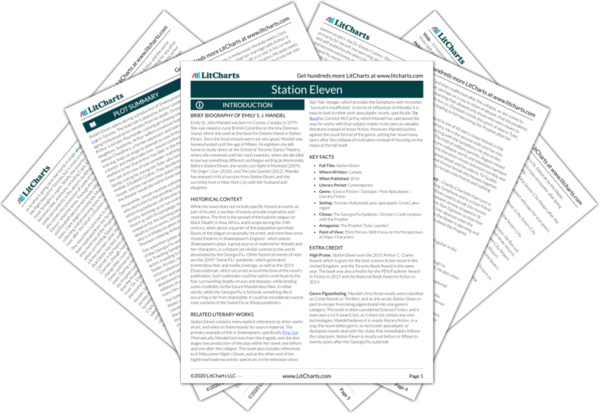Summary
Analysis
Back in Year Twenty, Kirsten and August leave the house they found. Kirsten can barely comprehend the idea of living in a house and locking the door behind her. Later, while they flip through the magazines Kirsten found in the house, they discuss the theory of parallel universes. They like to imagine universes where the pandemic never happened, or where civilization hadn’t been so devastated by the Flu. In one alternate universe, August suggests, it might have been Kirsten on the cover of tabloids.
The parallel universe theory discussion is a scientific worldview that contrasts with the faith-centric cult of the prophet. Instead of believing that everything happens for a reason, the Georgia Flu is simply something that happened randomly in this universe but also didn’t happen in an infinite number of other places.
Themes
As she looks through the magazines, Kirsten discovers a photo of Miranda Carroll visiting the production of King Lear in Toronto. Kirsten realizes that she was in the building at that very moment, but can’t remember exactly if she saw Miranda there. August notes that the photo is from two weeks before the apocalypse, and Kirsten jokes, “At least the celebrity gossip survived.”
After they are done with the magazines, they continue discussing parallel universes. This conversation has become a game and an escape in their years of friendship. They wonder about other lives where civilization had continued, or where space travel has been invented, or where they have boarded Station Eleven. They also imagine worse universes, for example a universe where Kirsten remembered her first year on the road and what caused the scar on her face. The conversation ends with a parallel universe where Sayid and Dieter didn’t disappear (or a parallel universe where they could just call them on cellphones).
The theory of parallel universes is an escape to contrast the prophet’s faith, but the conversation itself forms another kind of escape. It is a safe space, a familiar conversation that provides continuity in their relationship. Of course, it also helps to point out the frustrations of living without civilization, as in a parallel universe Kirsten and August could simply call the missing friends whose very absence has driven them to this conversation about hypotheticals.
Themes
When the conversation turns to Sayid and Dieter, Kirsten and August get moving again. They are close to Severn City now, but they decide they don’t want to travel at night, so they set up camp in the backyard of an abandoned home. As they are falling asleep, August thinks about the man at the gas station (Finn) and the scar on his face. He tells Kirsten he realized what it is, and Kirsten says it was a mark from the prophet. But August has realized what the symbol is: it’s an airplane.
After thinking about the absence of their friends, the reality of which universe they actually live in overcomes Kirsten and August and they are forced to keep moving. August’s realization complicates the symbolism of airplanes, as strange notions of faith, marking other humans, and the prophet himself are juxtaposed with the ideas of hope, technology, and civilization that planes already have come to symbolize.
Themes
Get the entire Station Eleven LitChart as a printable PDF.













